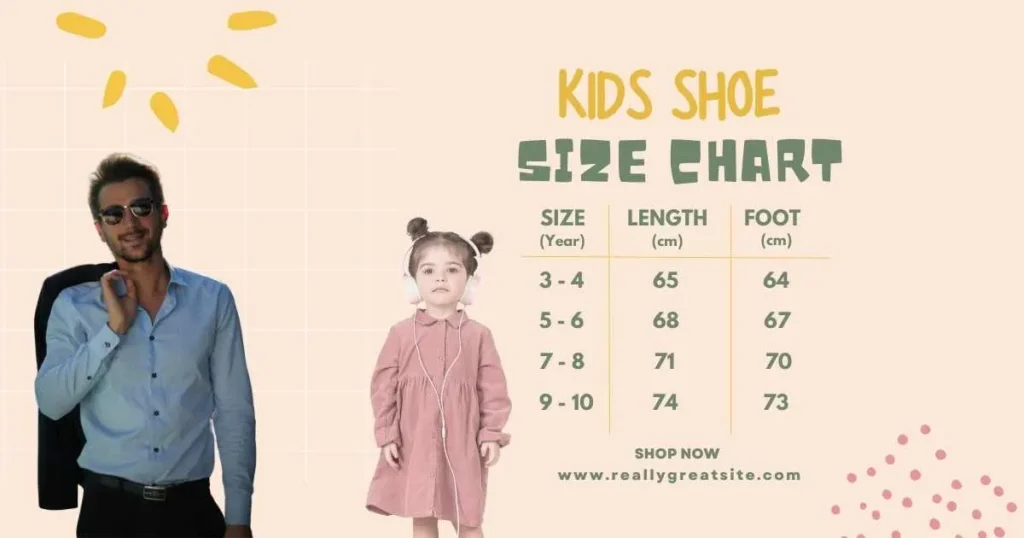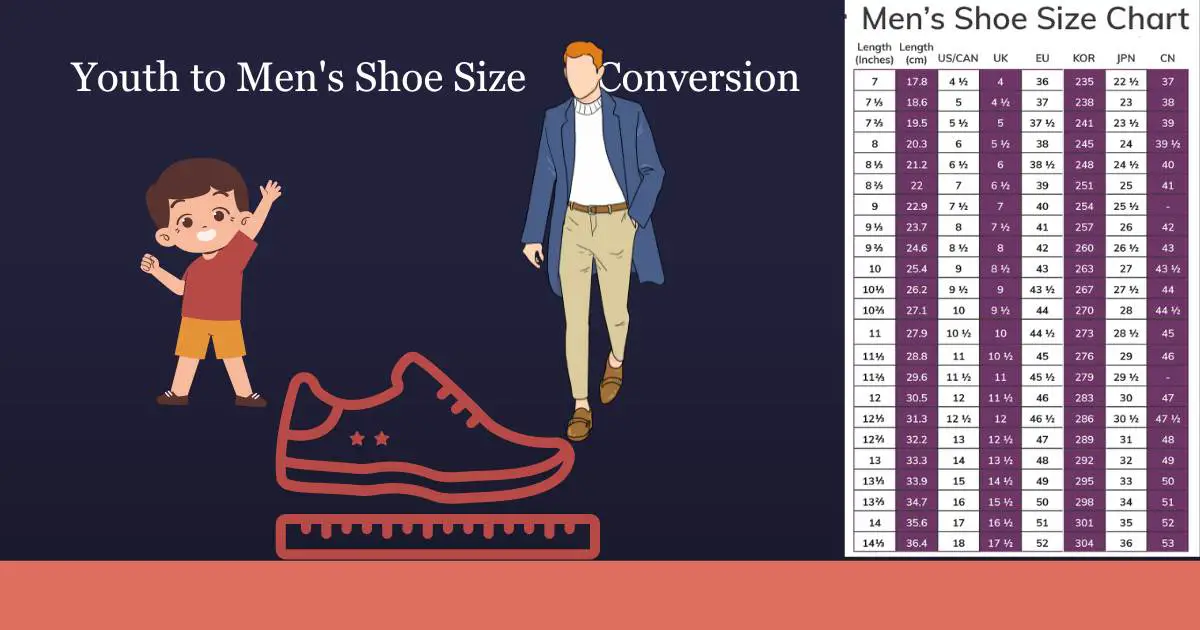Curious about how to convert youth shoe sizes to men’s sizes? It’s actually quite simple! Generally, you just need to subtract 1.5 to 2 from the youth size to find the equivalent men’s size. For instance, if you have a youth size 7, it would typically translate to a men’s size 5.5 or 6. Through my research and experience, I’ve found this conversion to be a common query among shoppers. By understanding this straightforward process, readers can easily shop for shoes for growing kids or find the right fit when transitioning from youth to men’s sizes. So, if you’ve ever wondered how to convert youth shoe sizes, keep reading to learn all about it!
Converting Youth Sizes To Men’s Sizes
Transitioning from youth to men’s shoe sizes can seem tricky. But with the right steps, it’s simple! Shoe sizes aren’t universal, and typically, men’s sizes start just after youth sizes end. Understanding how they convert helps in finding the perfect fit. Whether it’s for sports, school, or casual wear, getting shoe size conversion right is essential for comfort and performance.
Determining The Starting Point
To start, find the current youth shoe size. It’s the number to use for conversion. Take a look at the most recent pair of shoes. The size should be inside the shoe or on a label. Shoes from different brands might vary in size. Check a few pairs if possible. This gives a better average size to work with.
Measure the foot in millimeters (mm) for accuracy. This extra step helps refine the starting point.
Calculating The Conversion
The general rule for converting youth to men’s sizes is to add 0.5 or 1 to the youth size. This is because men’s shoes are typically wider and slightly longer than youth sizes. Here is a simple way to see the conversion:
| Boy’s Size | Men’s Size |
|---|---|
| 7Y | 7.5M or 8M |
| 6Y | 6.5M or 7M |
| 5Y | 5.5M or 6M |
| 4Y | 4.5M or 5M |
| 3Y | 3.5M or 4M |
These conversions vary with different shoe brands. Remember to check the brand’s specific sizing chart for the best fit.
Adjusting For Potential Discrepancies
Shoe sizes can have small differences. They depend on the shoe type and brand. Feet can also swell throughout the day. This affects the fit of the shoe. It’s best to try shoes on in the afternoon. Feet are the largest then.
- If the shoe feels tight, go up half a size.
- If it’s too loose, try a half-size smaller.
Pay attention to width as well. Men’s shoes come in different widths. Youths do not often face this issue. But in men’s sizes, getting the right width is just as important as length.
Youth To Men’s Shoe Size Conversion Mm
This conversion can also be measured in millimeters. Since not all shoe sizes align perfectly across regions, conversion in mm provides a precise method to transfer between youth and men’s shoe sizes. To make this work, use a size chart that includes mm measurements.
Here’s an example:
| Youth Size (mm) | Approx. Men’s Size (mm) |
|---|---|
| 241mm | 245mm or 250mm |
| 245mm | 250mm or 255mm |
| 250mm | 255mm or 260mm |
| 255mm | 260mm or 265mm |
| 260mm | 265mm or 270mm |
Using the foot measurement taken earlier, match it to the closet men’s size in mm. A snug fit is around 10-15mm longer than the foot length.
Remember, practice makes perfect when converting shoe sizes. Trying on a few different pairs is always the best approach!
Why Is Shoe Size Conversion Important?
Shoe size conversion is crucial in finding the perfect fit. Different age groups have different sizing charts. As youth grow into their teen years, their feet do too. This growth means they will graduate from youth to men’s shoe sizes. Without accurate size conversion, shoes might pinch or cause blisters. It also helps avoid the hassle of returning ill-fitting shoes, saving both time and money.

Differences In Sizing Systems
Sizing systems vary widely across regions. The same shoe may have different sizes in the US, UK, and Europe. Youth sizes, often denoted by a ‘Y’, can correspond to a smaller men’s size. Here are key differences:
- Children’s sizes typically run up to size 7Y.
- Men’s sizes usually start at size 7 for adults.
- The lengths and widths of shoes might differ despite similar sizing numbers.
A shoe size conversion chart is invaluable for making sense of these differences.
Purchasing Shoes From Overseas
Shopping for shoes from international brands? Understanding conversion is essential. Different countries use unique sizing systems. With global online shopping, many people buy shoes from other countries. A conversion chart ensures that youth sizes align with men’s sizes abroad. Always check the seller’s sizing guide. Each brand might have slight variations, even within the same sizing system.
Understanding The Youth Shoe Size Chart
Understanding the youth shoe size chart is a step toward a perfect fit. Shoe size conversion from youth to men’s sizes can puzzle parents and young adults alike. When kids outgrow their children’s shoes, the transition to men’s sizes requires understanding the differences in sizing charts. Let’s unravel this with age-appropriate examples and brand-specific variations.
Age Range And Shoe Sizes
Shoe sizes change with age. The chart below simplifies this change for a smoother shopping experience.
| Age | Youth Shoe Size | Men’s Shoe Size Equivalent |
|---|---|---|
| 12-13 Years | 5Y – 7Y | 5 – 7 |
| 14+ Years | 7Y and up | 7 and up |
Typically, youth sizes run from size 3.5 to 7. When a youth size surpasses 7, it aligns with men’s shoe sizes. Not every child’s growth is the same, so use this as a general guide.
Variations Between Brands
Brands have unique sizing. This list details the differences to aid in selecting the right size.
- Nike typically fits smaller than other brands.
- Adidas shoes may run true to size or slightly larger.
- Under Armour offers consistent sizes, very close to one’s actual foot size.
Always check brand-specific size charts. Try on shoes when possible. Measure the child’s foot to compare with online size guides.
Tips For A Successful Conversion
Navigating the path from youth to men’s shoe sizes should be seamless. With the right tips and tricks, anyone can make an accurate transition. Here’s a helpful guide on how to successfully convert shoe sizes.
Trying On Shoes Before Buying
Finding the perfect fit sometimes requires trial and error. Always try shoes on before making a purchase to avoid discomfort and wasted money.
- Visit stores in the afternoon when feet are largest.
- Wear the socks you plan to wear with the new shoes.
- Walk around in the shoes to check for any tightness or discomfort.
Knowing Your Foot Measurements
Accurate foot measurements are the cornerstone of a successful shoe size conversion. Calculate your foot size regularly, as it can change over time.
- Stand on a piece of paper and trace your foot.
- Measure the length from the longest toe to the heel.
- Use a conversion chart to find the corresponding shoe size.
Considering The Shoe Styles
Every shoe style fits differently. Look at the design and material of the shoe for hints about its fit. Consider these factors:
| Style | Considerations |
| Sneakers | Usually true to size, comfortable for everyday wear. |
| Dress Shoes | May run narrow, opt for a wider fit if needed. |
| Boots | Consider extra room for socks, especially thick ones. |
Common Challenges And Solutions
Navigating through shoe sizes from youth to men’s categories can seem like plotting a course through a maze. This journey has pitfalls ranging from brand inconsistencies to sizing chart confusion. Let’s chart the course to find simple, effective solutions to these common challenges.
Inconsistencies In International Sizing
Picture this: You find the perfect pair of shoes. But wait, the size chart looks unfamiliar. That’s because shoe sizes vary across different countries. A US size might not match a UK or European size. This confusion can send your search for the right shoe off-track.
Solution: Use international conversion charts. Here is a simple table to help you convert youth sizes to men’s:
| US Youth | US Men’s | UK | Europe |
|---|---|---|---|
| 6 | 6 | 5.5 | 38.5 |
| 7 | 7 | 6.5 | 40 |
| 8 | 8 | 7.5 | 41.5 |
| 9 | 9 | 8.5 | 42.5 |
Bear in mind, that individual brands can still vary slightly. Always check brand-specific charts.
Half Sizes And Width Variations
Unlike kids’ shoes, men’s sizes come with more options, like half sizes and different widths. This means a better fit but also more complexity when choosing the right shoe.
Solution: Measure your feet correctly. Length is just one aspect. Don’t forget width, especially if your foot is wider or narrower than average. Look for brands that offer a variety of widths.
- Remember to measure in the afternoon (feet swell during the day).
- Stand while measuring for the most accurate size.
- Consider the type of socks you’ll wear with the shoes.
Bonus Tip: Some stores offer foot-measuring services. Take advantage of this for an expert fit.
Frequently Asked Questions
How To Convert Youth Shoe Sizes To Men’s?
Converting youth sizes to men’s involves subtracting 0. 5 to 1. 0 from the youth size to obtain the equivalent men’s size.
What Is The Youth-to-Men Shoe Size Equivalent?
Youth sizes are typically 1. 5 sizes smaller than men’s, so a size 7 in youth would be a men’s 5. 5.
Can Adult Men Wear Youth-sized Shoes?
Men can wear youth-sized shoes if the shoe’s size is 1. 5 smaller than their typical men’s size, offering a potential fit.
Conclusion
Understanding shoe size conversion is key as youngsters transition into adult sizes. Mastery of this ensures comfortable, well-fitted footwear for growing feet. Consult size charts for precision, and remember, proper measurement offers the best-fit guarantee. Embrace this guide to ease your selection process, ensuring style meets comfort every step of the way.


